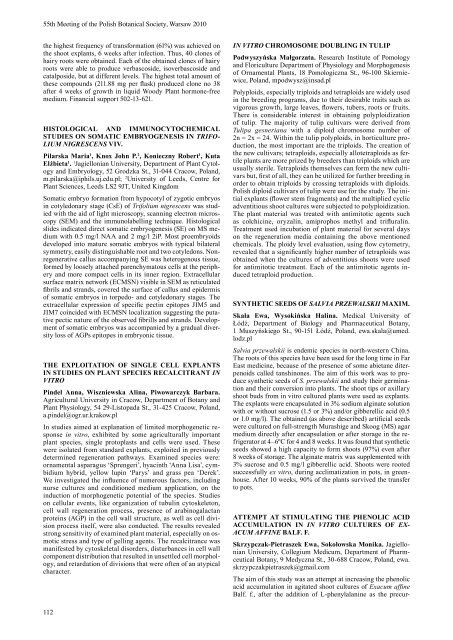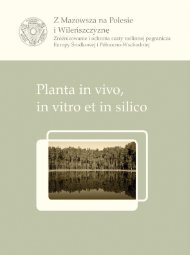acta societatis botanicorum poloniae - LV Zjazd Polskiego ...
acta societatis botanicorum poloniae - LV Zjazd Polskiego ...
acta societatis botanicorum poloniae - LV Zjazd Polskiego ...
Create successful ePaper yourself
Turn your PDF publications into a flip-book with our unique Google optimized e-Paper software.
55th Meeting of the Polish Botanical Society, Warsaw 2010<br />
the highest frequency of transformation (61%) was achieved on<br />
the shoot explants, 6 weeks after infection. Thus, 40 clones of<br />
hairy roots were obtained. Each of the obtained clones of hairy<br />
roots were able to produce verbascoside, isoverbascoside and<br />
catalposide, but at different levels. The highest total amount of<br />
these compounds (211.88 mg per flask) produced clone no 38<br />
after 4 weeks of growth in liquid Woody Plant hormone-free<br />
medium. Financial support 502-13-621.<br />
HISTOLOGICAL ANd IMMUNOCYTOCHEMICAL<br />
STUdIES ON SOMATIC EMBrYOGENESIS IN trifolium<br />
niGrescens VIV.<br />
Pilarska Maria1 , Knox John P. 2 , Konieczny robert1 , Kuta<br />
Elżbieta1 . 1Jagiellonian University, Department of Plant Cytology<br />
and Embryology, 52 Grodzka St., 31-044 Cracow, Poland,<br />
m.pilarska@iphils.uj.edu.pl; 2University of Leeds, Centre for<br />
Plant Sciences, Leeds LS2 9JT, United Kingdom<br />
Somatic embryo formation from hypocotyl of zygotic embryos<br />
in cotyledonary stage (CsE) of Trifolium nigrescens was studied<br />
with the aid of light microscopy, scanning electron microscopy<br />
(SEM) and the immunolabelling technique. Histological<br />
slides indicated direct somatic embryogenesis (SE) on MS medium<br />
with 0.5 mg/l NAA and 2 mg/l 2iP. Most proembryoids<br />
developed into mature somatic embryos with typical bilateral<br />
symmetry, easily distinguishable root and two cotyledons. Nonregenerative<br />
callus accompanying SE was heterogenous tissue,<br />
formed by loosely attached parenchymatous cells at the periphery<br />
and more compact cells in its inner region. Extracellular<br />
surface matrix network (ECMSN) visible in SEM as reticulated<br />
fibrils and strands, covered the surface of callus and epidermis<br />
of somatic embryos in torpedo- and cotyledonary stages. The<br />
extracellular expression of specific pectin epitopes JIM5 and<br />
JIM7 coincided with ECMSN localization suggesting the putative<br />
pectic nature of the observed fibrills and strands. Development<br />
of somatic embryos was accompanied by a gradual diversity<br />
loss of AGPs epitopes in embryonic tissue.<br />
THE ExPLOITATION OF SINGLE CELL ExPLANTS<br />
IN STUdIES ON PLANT SPECIES rECALCITrANT in<br />
vitro<br />
Pindel Anna, Wiszniewska Alina, Piwowarczyk Barbara.<br />
Agricultural University in Cracow, Department of Botany and<br />
Plant Physiology, 54 29-Listopada St., 31-425 Cracow, Poland,<br />
a.pindel@ogr.ur.krakow.pl<br />
In studies aimed at explanation of limited morphogenetic response<br />
in vitro, exhibited by some agriculturally important<br />
plant species, single protoplasts and cells were used. These<br />
were isolated from standard explants, exploited in previously<br />
determined regeneration pathways. Examined species were:<br />
ornamental asparagus ‘Sprengeri’, hyacinth ‘Anna Lisa’, cymbidium<br />
hybrid, yellow lupin ‘Parys’ and grass pea ‘Derek’.<br />
We investigated the influence of numerous factors, including<br />
nurse cultures and conditioned medium application, on the<br />
induction of morphogenetic potential of the species. Studies<br />
on cellular events, like organization of tubulin cytoskeleton,<br />
cell wall regeneration process, presence of arabinogal<strong>acta</strong>n<br />
proteins (AGP) in the cell wall structure, as well as cell division<br />
process itself, were also conducted. The results revealed<br />
strong sensitivity of examined plant material, especially on osmotic<br />
stress and type of gelling agents. The recalcitrance was<br />
manifested by cytoskeletal disorders, disturbances in cell wall<br />
component distribution that resulted in unsettled cell morphology,<br />
and retardation of divisions that were often of an atypical<br />
character.<br />
112<br />
in vitro CHrOMOSOME dOUBLING IN TULIP<br />
Podwyszyńska Małgorzata. Research Institute of Pomology<br />
and Floriculture Department of Physiology and Morphogenesis<br />
of Ornamental Plants, 18 Pomologiczna St., 96-100 Skierniewice,<br />
Poland, mpodwysz@insad.pl<br />
Polyploids, especially triploids and tetraploids are widely used<br />
in the breeding programs, due to their desirable traits such as<br />
vigorous growth, large leaves, flowers, tubers, roots or fruits.<br />
There is considerable interest in obtaining polyploidization<br />
of tulip. The majority of tulip cultivars were derived from<br />
Tulipa gesneriana with a diploid chromosome number of<br />
2n = 2x = 24. Within the tulip polyploids, in horticulture production,<br />
the most important are the triploids. The creation of<br />
the new cultivars; tetraploids, especially allotetraploids as fertile<br />
plants are more prized by breeders than triploids which are<br />
usually sterile. Tetraploids themselves can form the new cultivars<br />
but, first of all, they can be utilized for further breeding in<br />
order to obtain triploids by crossing tetraploids with diploids.<br />
Polish diploid cultivars of tulip were use for the study. The initial<br />
explants (flower stem fragments) and the multiplied cyclic<br />
adventitious shoot cultures were subjected to polyploidization.<br />
The plant material was treated with antimitotic agents such<br />
as colchicine, oryzalin, amiprophos methyl and trifluralin.<br />
Treatment used incubation of plant material for several days<br />
on the regeneration media containing the above mentioned<br />
chemicals. The ploidy level evaluation, using flow cytometry,<br />
revealed that a significantly higher number of tetraploids was<br />
obtained when the cultures of adventitious shoots were used<br />
for antimitotic treatment. Each of the antimitotic agents induced<br />
tetraploid production.<br />
SYNTHETIC SEEdS OF sAlviA PrzewAlskii MAxIM.<br />
Skała Ewa, Wysokińska Halina. Medical University of<br />
Łódź, Department of Biology and Pharmaceutical Botany,<br />
1 Muszyńskiego St., 90-151 Łódź, Poland, ewa.skala@umed.<br />
lodz.pl<br />
Salvia przewalskii is endemic species in north-western China.<br />
The roots of this species have been used for the long time in Far<br />
East medicine, because of the presence of some abietane diterpenoids<br />
called tanshinones. The aim of this work was to produce<br />
synthetic seeds of S. przewalskii and study their germination<br />
and their conversion into plants. The shoot tips or axillary<br />
shoot buds from in vitro cultured plants were used as explants.<br />
The explants were encapsulated in 3% sodium alginate solution<br />
with or without sucrose (1.5 or 3%) and/or gibberellic acid (0.5<br />
or 1.0 mg/l). The obtained (as above described) artificial seeds<br />
were cultured on full-strength Murashige and Skoog (MS) agar<br />
medium directly after encapsulation or after storage in the refrigerator<br />
at 4– 6ºC for 4 and 8 weeks. It was found that synthetic<br />
seeds showed a high capacity to form shoots (97%) even after<br />
8 weeks of storage. The alginate matrix was supplemented with<br />
3% sucrose and 0.5 mg/l gibberellic acid. Shoots were rooted<br />
successfully ex vitro, during acclimatization in pots, in greenhouse.<br />
After 10 weeks, 90% of the plants survived the transfer<br />
to pots.<br />
ATTEMPT AT STIMULATING THE PHENOLIC ACId<br />
ACCUMULATION IN in vitro CULTUrES OF ex-<br />
Acum Affine BALF. F.<br />
Skrzypczak-Pietraszek Ewa, Sokołowska Monika. Jagiellonian<br />
University, Collegium Medicum, Department of Pharmceutical<br />
Botany, 9 Medyczna St., 30-688 Cracow, Poland, ewa.<br />
skrzypczakpietraszek@gmail.com<br />
The aim of this study was an attempt at increasing the phenolic<br />
acid accumulation in agitated shoot cultures of Exacum affine<br />
Balf. f., after the addition of L-phenylalanine as the precur-



